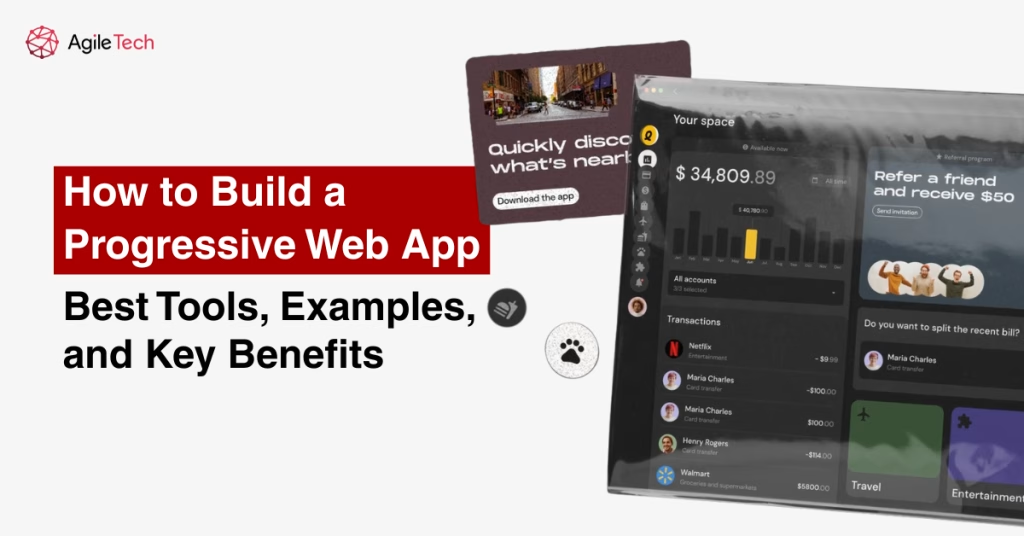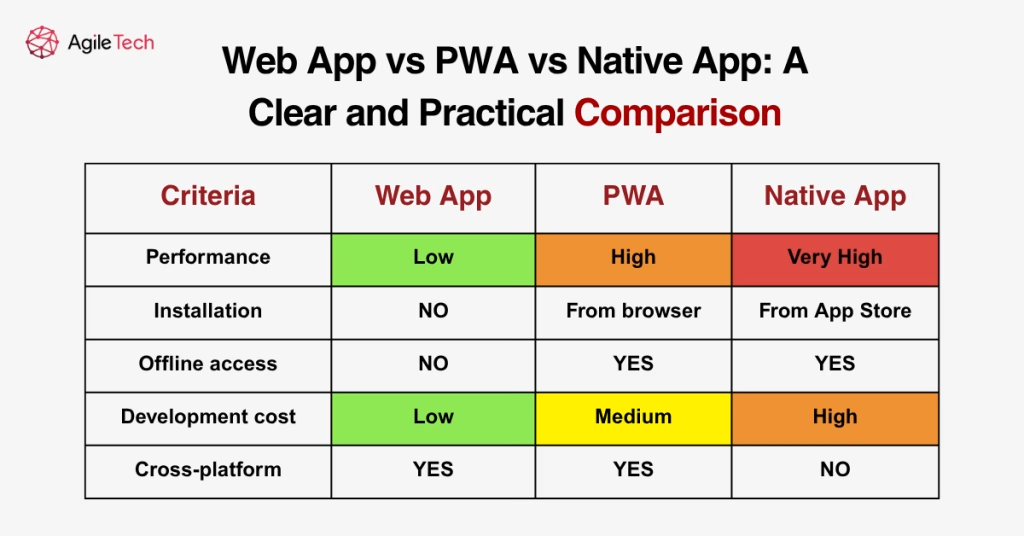How to Build a Progressive Web App: Best Tools, Examples, and Key Benefits
Progressive Web Apps (PWAs) have quickly become a preferred approach in modern web development. By combining the reach of the web with the performance of native apps, they offer businesses a powerful way to improve user engagement, speed, and accessibility, without the high cost of traditional mobile app development.
This article will guide you through what progressive web apps are, how they compare to other solutions, real-world examples of successful PWAs, and the best tools to build one effectively.

1. What is a Progressive Web App?
Imagine if your website could behave like an app, fast, reliable, and engaging, without needing users to visit the app store. That’s what a Progressive Web App (PWA) does. PWAs combine the best of web and mobile experiences, offering offline access, push notifications, and home screen installation. They’re built with standard web technologies like HTML, CSS, and JavaScript, but feel like native apps. PWAs bridge the gap between websites and mobile apps, offering users the convenience of both.
A Progressive Web App (PWA) is a modern type of web application that behaves like a native mobile app while using standard web technologies such as HTML, CSS, and JavaScript. It bridges the gap between traditional web experiences and mobile app functionality.

Key Features
Progressive Web Apps are designed to work across all screen sizes, from desktops to smartphones. They allow users to access content even when offline, thanks to service workers. The user experience is smooth and immersive, closely resembling that of a native app. Security is ensured through HTTPS protocols, which protect user data. PWAs are also SEO-friendly, making them easily discoverable through search engines. Features like push notifications help keep users engaged, and the ability to install the app directly from a browser enhances accessibility.
Thanks to these features, PWAs help businesses offer fast, reliable, and engaging user experiences across platforms.
2. Progressive Web App vs. Native App vs. Web App
Think of a native app as a custom-made suit tailored perfectly for one platform but costly and time-consuming to produce. A traditional web app is more like a one-size-fits-all jacket, accessible but lacking advanced features. A PWA, however, is like a stylish blazer with stretch fabric: it fits many, feels premium, and is surprisingly efficient. In this section, we’ll compare how each option performs in terms of technology, performance, distribution, and cost.
2.1. Development Technology
Native apps are developed using platform-specific languages like Swift or Java, making them optimized but costly. Web apps run entirely in browsers with limited interaction. PWAs combine the flexibility of web technologies with advanced APIs to provide app-like experiences.
2.2. Performance and Speed
Native apps offer optimal speed and performance due to their deep integration with device hardware. Web apps depend heavily on internet speed and browser behavior. PWAs achieve near-native performance through smart caching and fast loading strategies.
2.3. Distribution & Installation
Native apps must be approved and downloaded from app stores, which can slow down distribution. Web apps are instantly accessible via a URL. PWAs can be installed directly from the browser, skipping the app store process entirely.
2.4. Cost Efficiency
Developing native apps is expensive due to the need for separate builds and maintenance. Web apps are the most budget-friendly but limited in features. PWAs offer a cost-effective solution with strong capabilities across multiple platforms.
PWAs are an ideal choice for companies looking to strike a balance between reach, experience, and cost.
3. Best Examples of Progressive Web Apps
To truly understand the power of progressive web apps, let’s dive into real-world case studies across various industries. These examples highlight how PWAs can improve performance, increase user engagement, and cut down on development and operational costs. Each of these companies faced unique challenges and used PWAs to overcome them effectively.
3.1. Starbucks
Starbucks needed a mobile-friendly solution for customers who don’t always have access to stable internet, especially in emerging markets. Their PWA is only a fraction of the size of their native app and allows users to browse the menu, customize drinks, and add items to the cart offline. Once reconnected, the app syncs seamlessly. This strategy led to a twofold increase in daily active users, with a large portion coming from lower-end devices or spotty connections.
3.2. Uber
Uber’s mission to make ride-hailing accessible to everyone required an app that worked even in poor network conditions. Their PWA was designed to load in under three seconds on 2G, weighing in at just 50KB. This approach ensured that users anywhere from remote towns to urban centers, could book a ride with minimal data usage. It’s an excellent example of user-first engineering with performance as a core goal.
3.3. Pinterest
Pinterest struggled with low engagement from mobile users visiting their standard website. After implementing a PWA, they saw an immediate improvement. The app now loads faster, offers smoother interactions, and supports push notifications. Their metrics speak volumes: a 60% increase in mobile engagement, a 40% rise in time spent on site, and a 44% jump in ad revenue. It turned a high-bounce mobile experience into a revenue-generating engine.
3.4. Tinder
Tinder rebuilt its web experience using a PWA to deliver smoother performance, particularly for users with limited device storage. The result: their PWA is 90% smaller than the Android app, reducing load times while preserving all the core interactions. Users benefit from faster swipes, real-time updates, and seamless usage even on lower-end phones or slower networks.
3.5. Forbes
Forbes turned to PWA technology to modernize its digital content delivery. Their team prioritized speed and mobile accessibility. After launching the new site, average load time dropped from over 6 seconds to under 2.5 seconds. This led to users spending twice as long on articles, with an increase in return visits and ad impressions. For a media company, this level of engagement directly translates to revenue.
These examples show how businesses benefit from faster load times, broader reach, and improved engagement.
Read more: Top 10+ Best Web Development Frameworks to Upgrade Your Stack
4. Top Frameworks and Tools for Progressive Web App Development
Building a PWA is like constructing a modern house; you need the right foundation and smart tools to create something reliable, fast, and scalable. In this section, we’ll explore popular frameworks and toolkits that developers use to build progressive web apps, including React, Angular, Vue, and more.
4.1. React
React, developed by Facebook, is a powerful JavaScript library ideal for creating dynamic single-page applications. It integrates seamlessly with frameworks like Next.js, making it suitable for server-side rendering and SEO. Its strong community support and reusable components make development more efficient.
4.2. Angular
Angular, backed by Google, provides a complete framework with built-in tools to support service workers and routing. Its robust architecture is well-suited for building enterprise-level progressive web apps with maintainable code structures.
4.3. Vue.js
Vue.js is a lightweight and flexible framework that’s easy to learn and quick to integrate into existing projects. Its virtual DOM and integration with Nuxt.js make it an excellent choice for fast, SEO-friendly progressive web apps.
4.4. Ionic
Ionic allows developers to build hybrid apps using familiar web technologies like HTML, CSS, and JavaScript. It can be combined with Angular or React and offers access to native device features through plugins, making it ideal for cross-platform applications.
4.5. Workbox + Lighthouse (Tooling)
Workbox is a set of tools that simplify building efficient service workers for caching and background sync. Lighthouse is an auditing tool that evaluates your PWA’s performance and provides actionable insights to improve compliance with best practices.
Framework choice depends on your goals, scale, and developer familiarity.
5. Should You Build a Progressive Web App?
Not every solution needs a native app. If your users want quick access, minimal friction, and offline functionality, a PWA might be the perfect fit. Like choosing a hybrid car for efficiency and adaptability, PWAs give you powerful functionality without burning through your development budget. Let’s look at the benefits and limitations to help you decide.
Advantages
PWAs work across devices and platforms, allowing businesses to reach a broader audience. Their app-like experience ensures fast load times and smooth interactions. Even with poor network connectivity, users can access content offline. PWAs are more affordable to build and maintain than native apps and can be deployed without relying on app stores.
Considerations
PWAs face some limitations on iOS, such as restricted push notifications and limited background functionality. Additionally, they don’t have full access to native device features like Bluetooth or biometric authentication, which may be necessary for certain applications.
In most use cases, especially for e-commerce, media, and services, PWAs are an efficient and scalable solution.
Read more: 15+ Brilliant Web App Ideas To Make Money For Startups
6. How AgileTech Can Help You Build a Web App or PWA
Developing a high-quality progressive web app involves more than just writing code; it requires thoughtful planning, a strong understanding of user needs, and careful execution across design, development, and deployment. That’s where a reliable development partner comes in.
At AgileTech, we’ve worked with a wide range of clients from early-stage startups to large enterprises, helping them build responsive and scalable digital products. Our team combines technical expertise with a deep understanding of business goals to create web apps and PWAs that perform well and grow with your users.
We work with modern frameworks like React, Angular, and Vue, and our approach is grounded in agile methodology: iterative, transparent, and focused on value. Whether you’re building a prototype, migrating an existing system, or launching a brand-new platform, we can support you at every stage.
Conclusion
Progressive Web Apps are no longer optional; they’re the future of mobile-friendly digital experiences. They load fast, work offline, and keep users engaged longer.
If you’re seeking a cost-effective, scalable way to modernize your app or website, a progressive web app is the smart choice. Ready to build? Reach out to AgileTech and start building your PWA today.